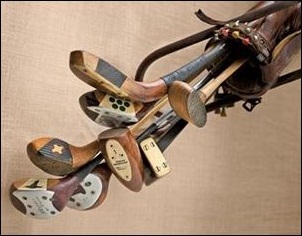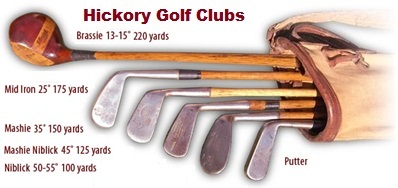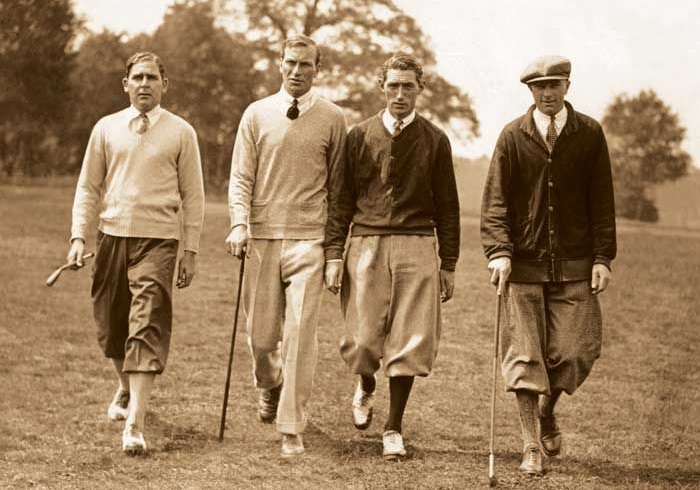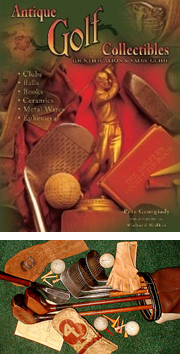Vintage Wooden Hickory Shaft Golf Clubs
Vintage Hickory Shaft Wooden Golf Club Guides to Identification and Value
As collectors of vintage golf equipment, those of us who are fascinated with wooden shaft golf clubs share a passion for these classics not only as vintage equipment, but also as art work and decor. After all, some of these hand crafted relics can be candy to the eye.
Whether you are a beginner or experienced antique hickory wood golf club collector, your fascination will only grow as you stumble upon unique woods and irons of a bygone era.
Early golf clubs were made entirely of wood. Not only was this material easy to shape, but it was also soft enough not to damage the stuffed leather golf balls that were used until the mid-1800s.
With the introduction of the hard rubber gutta-percha golf ball in 1848, golfers no longer had to worry about damaging the ball and began using clubs with iron heads.
 More
Cool Golf Stuff for Your Liking!
More
Cool Golf Stuff for Your Liking!
Until the early 1900s, all golf clubs had wooden shafts whether they had iron heads or wooden heads. The first steel-shafted golf clubs were made in the United States in the 1920s. It was about this time that some club makers started using the current numbering system to identify different clubs, rather than the old colorful names.
Old Vintage / Antique Hickory Shaft Wooden Golf Clubs
 In
times gone by, golf clubs used to have cool and creative sounding names,
not numbers, woods were made of wood and irons were made of iron, but all
bore a hickory wooden shaft.
In
times gone by, golf clubs used to have cool and creative sounding names,
not numbers, woods were made of wood and irons were made of iron, but all
bore a hickory wooden shaft.
Antique golf clubs had names instead of numbers and the names and numbers below are a guide to the modern equivalent of these ancient golfing weapons, relics of the game!
Antique Wood Golf Club Names Were Quite Colorful In The Past
WoodGolfClubs.Com Golf Club Identification Guide
Modern woods and irons as well as the putter were identified by some quite exotic club names in the past. Below you will see a chart that shows the club names that were replaced with the modern numbered clubs that are the common format today.
Woods; Original Name
- No.1 Wood; > Driver, Play Club
- No.2 Wood; > Brassie
- No.3 Wood; > Spoon Brassie
- No.4 Wood; > Wood Cleek, Baffy

Putter; > Blank
Wedge; > Niblick, Baffing Spoon
Irons; Original Name
- No.1; > Driving Iron, Cleek
- No.2; > Cleek, Mid Iron
- No.3; > Mid-Mashie
- No.4; > Jigger, Mashie Iron
- No.5; > Mashie
- No.6; > Spade Mashie
- No.7; > Benny
- No.8; > Mashie Niblick
- No.9; > Pitching Niblick

Wood Golf Club Valuation
For value purposes, hunting for antique hickory shaft golf clubs can include an effort to establish the wood golf clubs age as well as its identity. Wood golf club descriptions help to Identify and validate that you do in fact possess an authentic antique golf club. Establishing the identity of a golf club can include a history for the specific club itself. Was the club used by a famous celebrity or golfer or, was it used at a famous tournament or on a historic golf course. Better yet, is it a rare highly Collectible brand, or a specifically unique club? All these factors help when your looking to buy antique wood golf clubs.
 It
is seldom easy to precisely identify and distinguish an antique wood golf
club from one that is merely an old golf club since even metal shafts are
made to look like wood at times.
It
is seldom easy to precisely identify and distinguish an antique wood golf
club from one that is merely an old golf club since even metal shafts are
made to look like wood at times.
Fortunately, there are several hints that can help a lot with this process. Dating an antique golf club with relative accuracy to determine it's value can be done through an old golf club appraisal system.
Regardless of what intrigues you with these old hickory shaft classics, they bring back the thoughts of hand made perfection and the old style golf the way it was. The thoughts of walking the fairways in a jaunty cap, knickers and an old leather pair of wing tip golf shoes can keep you dreaming. Hear the swish and thwack of a well struck hickory shaft golf shot. Feel connected to those classic times and the way these old clubs played the ball.
A Guide to Playing The Game With Hickory Golf Clubs

Hickory clubs can often be heavier than other clubs so get use to your club by holding on to it loosely and waggle the head to get a feel for the club weight, then take a practice swing as you feel the club head weight through the full swing motion.
Hitting the Woods:
You should tee the ball a little lower than with a modern driver. Hickory shaft woods are usually more lofted like fairway woods between 12-20 degrees. These wooden golf club heads will naturally hit the ball lower than today’s drivers. These hickory shaft clubs will torque or twist more than modern club shafts, so keeping your swing as smooth as possible will help hit more accurately. You can hit the woods from a good lie in the fairway or short rough.
Hitting the Mid-Iron:
This is the least lofted iron in the bag, usually around 25 degrees. Kind of like a 2 or 3 iron, so it can be the hardest club to hit for some players. Others find that it is a great club that hits well and goes straighter than a wood off the tee. All in all, you’ll have to try it to see how you do...
Hitting the Mashie:
Lofted like today’s 6-7 iron, it's a good choice for up to 140-150 yards for a common player. They are also a good choice for "chip and run" shots around the green. Choose this club to move the ball forward in the fairway or from a good lie in the rough. Try the mashie with a putter like stroke around the green for bump and run shots..
Hitting the Mashie Niblick:
Usually a good club for hitting an approach shot to the green. With about a 45 degrees loft it is fairly equivalent to an 8 iron and a good club to choose from about 100-125 yards. Use it for easy swing approach shots to land in front of the pin and roll up close. With hickory clubs you should anticipate ending up a little bit further than you would with modern clubs that generate more spin.
Hitting the Niblick:
The niblick a shorter hitting club similar to the 9 iron or a pitching wedge. It has a hitting range of around 70-100 yards. Use this club for pitching lofted shots around the green and approaches where you need to carry, or out of a bunker. Niblicks are often found to have sharp “digging” leading edges and are a little tricky off a thin lie. It's an easiest club to “chunk” because of the thin leading edge and loft.
The Blank / Putter:
Hickory shaft putters are usually made of forged steel and have a great feel when struck in the sweet spot. Hold them lightly in your hands and practice a smooth swing for comfort and accuracy.

